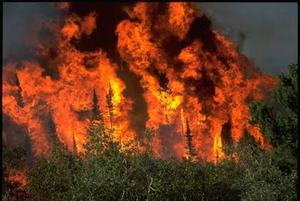WildfiresSuppressing naturally occurring blazes increases wildfire risk
According to the National Interagency Fire Center, 9.3 million U.S. acres burned in wildfires in 2012 compared with 3.57 million acres affected in 2001 and 2.95 million in 1991. One reason for the increase in the number of acres consumed by wildfires is the U.S. government’s policy of suppressing of naturally occurring blazes. Researchers say that this policy can have unintended consequences, including making wildfires more severe.

Suppressing wildfires may result in more intense blazes // Source: ucsb.edu
Who could find fault with Smokey Bear, the gentle Ursus whose advice many Americans grew up following?
Perhaps the spotted owl, for starters. To flourish, the endangered bird which is native to the western United States needs certain types of forests which are not found in places where severe wildfires have occurred. Smokey, of course, encourages people to prevent fires, not to start them. Suppression of naturally occurring blazes, however, can have unintended consequences. Whether those include increasing the possibility for wildfires to become severe has been the focus of research recently completed by Alan Taylor, Penn State professor of geography.
A Penn State University release reports that Taylor studied a mixed conifer forest in the Lassen National Forest in northern California known as the Cub Creek Research Natural Area, site of a wildfire in 2008. The fact that Cub Creek has never been logged allowed Taylor to look at whether a forest would burn the same way in two different time periods: the 1880s, before fire suppression policy took effect, and 2008, when suppression was being practiced.
Taylor analyzed satellite data and field measurements using a statistical model known as “Random Forest,” which predicts fire severity patterns based on characteristics of the terrain, fuels, vegetation, and weather. He found that, in general, the burning patterns were similar but with one important difference.
“We lost more of the forest in the valley bottom because of the changes caused by fire suppression,” he said. “We lost 20 to 25 percent more than expected of the large, older growth trees.”
As Taylor explained, the high severity portions of the 2008 fire affected not only younger forests on upper slopes and ridge tops that had burned severely in the nineteenth century but older, more diverse forests in the valleys that had escaped high severity fire in the past. Tree-ring dating of fire scars shows that forests in the valley had burned many times in the past 300 years but not severely, he said.
“Historically, fires operated in a way that tended to be less severe in valley bottoms and lower slopes,” Taylor added. “Now, because of fire suppression, they tend to burn at a higher severity and you lose that habitat.” The practice of not allowing any fires means that more leaf litter and branches — the components of forest fuel — can accumulate on the floor, while small trees that would have burned in the past can grow large enough to carry fires into the crowns of the taller trees that had escaped the impact of less severe fires in the past, putting the landscape in jeopardy.
The Cub Creek area is a mixed conifer forest. Mixed conifers — sugar pines, ponderosa pines, black oaks, Douglas firs and big leaf maples, some reaching heights of fifty meters and diameters of 1.8 meters — have historically burned frequently.
They also are home to the endangered spotted owl.
“They nest in old forests with multiple layers that haven’t been burned at high severity, but have burned at low severity. They tend to occupy valley bottoms and slopes,” Taylor said of the birds.
To compare fire patterns of the late nineteenth and early twenty-first centuries, Taylor used “Random Forest.” Mapping the severity of fires on the Cub Creek forest required taking detailed measurements of variables including tree mortality, crown scorch, the amount of bark char, surface fuel consumption, and tree height and diameter.
Taylor also used satellite data to map the severity of impact. These findings were then compared with predictions of nineteenth century fire severity produced using the statistical model. The match was close except for the occurrence of more high severity fire on lower slopes.
According to the National Interagency Fire Center, 9.3 million U.S. acres burned in wildfires in 2012 compared with 3.57 million acres affected in 2001 and 2.95 million in 1991.
Taylor said that one approach for managing forest fires is selectively to alter the fuel structure. That would mean removing particular trees to discourage a fire from spreading with the same intensity across a landscape, and making sure that the crowns of certain trees are not touching so it is not as easy for a fire to jump from one to another. Reduction of surface fuel can be achieved by using prescribed fire.
“The best approach is targeting the spatial location of your treatments so they have the largest effect on fire severity,” Taylor said.
It also means asking the question of whether all wildfires should be suppressed.
The Random Forest modeling method could be used to help address those questions, aiding forest managers as they decide the best approach for keeping areas known as wild land-urban interfaces — places where people live near woods — safe from high severity fire.
